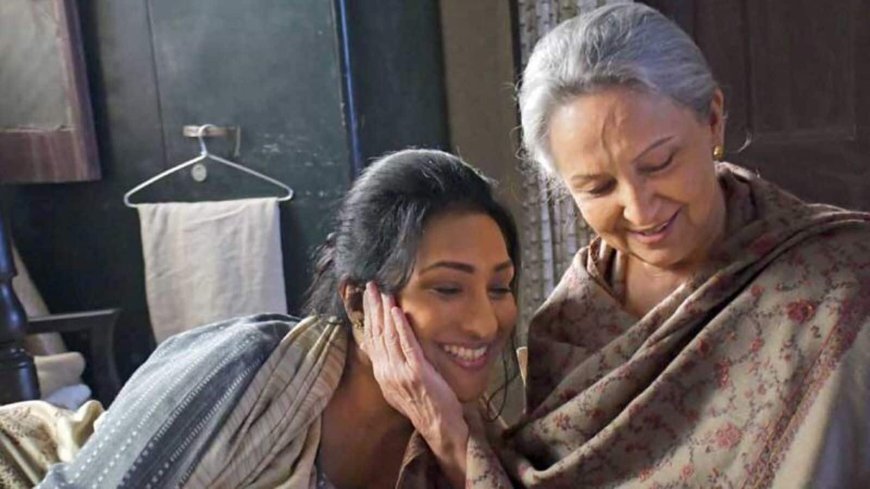Sharmila Tagore, Raakhee Draw Bengali Viewers In with Family Films, Defying Local Trends
Veteran stars Sharmila Tagore and Raakhee are drawing Bengali audiences back to cinemas with powerful family dramas, defying local trends and reshaping the regional film market.

Kolkata: June 19, 2025 – In a cinematic landscape increasingly dominated by action thrillers, gritty political dramas, and youthful romances, two legendary actresses—Sharmila Tagore and Raakhee—are quietly reshaping the box office narrative in Bengal. Their recent ventures into emotionally layered family dramas are not only drawing in multigenerational audiences but also challenging prevailing assumptions about what kind of films can succeed in regional markets.
Rekindling Nostalgia, Redefining Relevance
The latest Bengali-language film “Chhaya Bhor” starring Sharmila Tagore and “Nirbho Nirapod” featuring Raakhee, both released within a month of each other earlier this year, have seen strong performances at the box office. Unlike typical commercial hits led by male superstars or youth-centric romantic tales, these films center on familial bonds, generational divides, and quiet resilience, topics traditionally deemed “niche” or “arthouse.”
According to film trade analyst Anirban Chattopadhyay, “There is a palpable shift in Bengali cinema where veteran actresses like Sharmila and Raakhee are becoming the faces of a mature, story-first film movement. These films are drawing viewers not only for nostalgia but for the honesty and emotional depth they bring.”
Box Office and Audience Response
“Chhaya Bhor,” directed by Rituparna Sengupta, which portrays the struggles of an estranged mother trying to reconnect with her children, grossed over ₹5.2 crore in West Bengal within the first three weeks—a strong performance for a film with minimal promotional spend. Similarly, Raakhee’s “Nirbho Nirapod,” a tale of a retired schoolteacher uncovering her family’s hidden truths, crossed ₹4.7 crore during its opening run.
Critics and audiences alike have praised both performances. Sharmila Tagore’s subtle portrayal of a widow navigating her place in a modern family has been hailed as “deeply human” by The Statesman, while Raakhee’s character arc was termed “a masterclass in restraint” by Ananda Bazar Patrika.
Interestingly, these films also reported a higher-than-average attendance among 40+ and female audiences, indicating a shift in the regional viewership base—an underserved demographic that’s finally finding voice and representation on screen.
Why the Shift Now?
Industry insiders believe that the post-pandemic film market has opened the door for more experimental and emotionally resonant content. As big-budget Bollywood releases increasingly prioritize OTT and multiplex distribution, regional cinema in Bengal is seizing the opportunity to cater to local tastes with rooted storytelling.
Filmmaker Kaushik Ganguly, speaking at the Kolkata Film Society, remarked, “The audience today is smarter and more emotionally literate. They are willing to watch stories that reflect their own realities—aging, loneliness, fractured families—topics that Raakhee and Sharmila’s films are unafraid to explore.”
The digital marketing strategy around these films has also played a crucial role. With modest yet effective campaigns that relied on YouTube trailers, Facebook reels, and targeted WhatsApp promotions in urban and suburban Bengali-speaking clusters, both films created buzz without the need for aggressive traditional media spend.
Defying Industry Norms and Setting New Ones
Traditionally, the Bengali film industry has struggled to attract audiences over 35 years of age, with a heavy reliance on college-going viewers and fan bases of popular male actors. However, the success of these veteran-led family dramas is encouraging producers to reconsider their target markets.
Sushmita Roy, a cultural economist at Jadavpur University, notes: “This is a classic case of market correction. For years, a section of the audience was ignored. Now, by focusing on quality scripts and experienced actors, producers are unlocking a new value chain.”
Already, two new films starring seasoned actresses Mamata Shankar and Lily Chakravarty have gone into pre-production, banking on this emerging appetite for mature storytelling.
Investor and Market Outlook
From an investment perspective, this evolving trend suggests a diversification opportunity in the regional content portfolio. Production houses such as Shree Venkatesh Films and SVF Entertainment have reported better-than-expected returns on films with smaller budgets and experienced casts.
A senior executive at a Kolkata-based production studio revealed under anonymity, “We are seeing RoI ratios of nearly 3:1 on films led by veteran female actors. It’s not just art cinema anymore—it’s good business.”
OTT platforms like Hoichoi and Addatimes have also expressed interest in acquiring digital rights for such titles post-theatrical run, further boosting their commercial value.
The Road Ahead
As Sharmila Tagore and Raakhee continue to challenge norms with their graceful yet powerful on-screen presence, the Bengali film industry appears poised for a creative reawakening. Their success is not just a personal comeback—it’s a signal that content-driven cinema with emotional depth and mature characters can be both critically acclaimed and commercially viable.
In a world of rapidly changing tastes and fleeting digital content, it is heartening to see that stories grounded in love, loss, and reconciliation still have the power to move audiences and reshape markets.
What's Your Reaction?
 Like
0
Like
0
 Dislike
0
Dislike
0
 Love
0
Love
0
 Funny
0
Funny
0
 Angry
0
Angry
0
 Sad
0
Sad
0
 Wow
0
Wow
0













































































